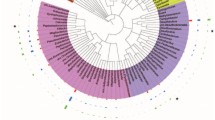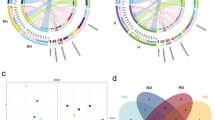Abstract
Objectives
To explore microbial communities associated with health and disease status around teeth and dental implants.
Materials and methods
A total of 10 healthy, 24 periodontitis, and 24 peri-implant sites from 24 patients were sequenced by next-generation sequencing. Microbial DNA was extracted and 16S rRNA gene was amplified. Bioinformatic analyses were performed using quantitative insights into microbial ecology (QIIME), linear discriminant analysis effect size (LEfSE), and STAMP.
Results
Differences in microbial diversity across three types of sites were not statistically significant. Several genera and species were more prevalent in healthy compared with diseased sites, including Lautropia, Rothia and Capnocytophaga and Kingella. Among diseased sites, Peptostreptococcaceae, Dialister, Mongibacterium, Atopobium, and Filifactor were over-represented in peri-implantitis sites, while Bacteroidales was more abundant in periodontitis sites.
Conclusions
Diseased periodontal and peri-implant sites and corresponding healthy sites have distinct microbiological profiles. These findings suggest that microbial analyses could identify biomarkers for periodontal health and disease and lead to the development of new strategies to improve periodontal health and treat peri-implant and periodontal diseases.
Clinical relevance
The study contributes to improving our understanding of healthy, periodontally affected, and peri-implantitis sites which can improve our ability to diagnose, monitor, and manage these oral conditions.





Similar content being viewed by others
References
Derks J, Tomasi C (2015) Peri-implant health and disease. A systematic review of current epidemiology. J Clin Periodontol 42(Suppl 16):S158–S171
Page RC, Kornman KS (1997) The pathogenesis of human periodontitis: an introduction. Periodontol 2000(14):9–11. https://doi.org/10.1111/j.1600-0757.1997.tb00189.x
Taylor GW, Borgnakke WS (2007) Self-reported periodontal disease: validation in an epidemiological survey. J Periodontol 78(Suppl 7S):1407–1420. https://doi.org/10.1902/jop.2007.060481
Kornman KS (2008) Mapping the pathogenesis of periodontitis: a new look. J Periodontol 79(8 Suppl):1560–1568. https://doi.org/10.1902/jop.2008.080213
Heitz-Mayfield LJ (2008) Peri-implant diseases: diagnosis and risk indicators. J Clin Periodontol 35(8 Suppl):292–304. https://doi.org/10.1111/j.1600-051X.2008.01275.x
Hajishengallis G, Lamont RJ (2021) Polymicrobial communities in periodontal disease: their quasi-organismal nature and dialogue with the host. Periodontol 2000 86(1):210–230. https://doi.org/10.1111/prd.12371
Schwarz F, Derks J, Monje A, Wang HL (2018) Peri-implantitis. J Clin Periodontol 45(Suppl 20):S246-s266. https://doi.org/10.1111/jcpe.12954
Rakic M, Galindo-Moreno P, Monje A, Radovanovic S, Wang HL, Cochran D, Sculean A, Canullo L (2018) How frequent does peri-implantitis occur? A systematic review and meta-analysis. Clin Oral Investig 22(4):1805–1816. https://doi.org/10.1007/s00784-017-2276-y
Jepsen S, Berglundh T, Genco R, Aass AM, Demirel K, Derks JE, Giovannoli JL, Goldstein M, Lambert F, Ortiz-Vigon A, Polyzois I, Salvi GE, Schwarz F, Serino G, Tomasi C, Zitzmann NU (2015) Primary prevention of peri-implantitis: managing peri-implant mucositis. J Clin Periodontol 42(Suppl 16):S152-157. https://doi.org/10.1111/jcpe.12369
Tomasi C, Derks J (2012) Clinical research of peri-implant diseases—quality of reporting, case definitions and methods to study incidence, prevalence and risk factors of peri-implant diseases. J Clin Periodontol 39(Suppl 12):207–223. https://doi.org/10.1111/j.1600-051X.2011.01831.x
Ong CT, Ivanovski S, Needleman IG, Retzepi M, Moles DR, Tonetti MS, Donos N (2008) Systematic review of implant outcomes in treated periodontitis subjects. J Clin Periodontol 35(5):438–462. https://doi.org/10.1111/j.1600-051X.2008.01207.x
Monje A, Alcoforado G, Padial-Molina M, Suarez F, Lin GH, Wang HL (2014) Generalized aggressive periodontitis as a risk factor for dental implant failure: a systematic review and meta-analysis. J Periodontol 85(10):1398–1407. https://doi.org/10.1902/jop.2014.140135
Pesce P, Canullo L, Grusovin MG, de Bruyn H, Cosyn J, Pera P (2015) Systematic review of some prosthetic risk factors for periimplantitis. J Prosthet Dent 114(3):346–350. https://doi.org/10.1016/j.prosdent.2015.04.002
Lang NP, Berglundh T (2011) Periimplant diseases: where are we now?—Consensus of the Seventh European Workshop on Periodontology. J Clin Periodontol 38(Suppl 11):178–181. https://doi.org/10.1111/j.1600-051X.2010.01674.x
Staubli N, Walter C, Schmidt JC, Weiger R, Zitzmann NU (2017) Excess cement and the risk of peri-implant disease — a systematic review. Clin Oral Implants Res 28(10):1278–1290. https://doi.org/10.1111/clr.12954
Belibasakis GN (2014) Microbiological and immuno-pathological aspects of peri-implant diseases. Arch Oral Biol 59(1):66–72. https://doi.org/10.1016/j.archoralbio.2013.09.013
Belibasakis GN, Charalampakis G, Bostanci N, Stadlinger B (2015) Peri-implant infections of oral biofilm etiology. Adv Exp Med Biol 830:69–84. https://doi.org/10.1007/978-3-319-11038-7_4
Darveau RP, Curtis MA (2021) Oral biofilms revisited: A novel host tissue of bacteriological origin. Periodontol 2000 86(1):8–13. https://doi.org/10.1111/prd.12374
Joseph S, Curtis MA (2021) Microbial transitions from health to disease. Periodontol 2000 86(1):201–209. https://doi.org/10.1111/prd.12377
Fürst MM, Salvi GE, Lang NP, Persson GR (2007) Bacterial colonization immediately after installation on oral titanium implants. Clin Oral Implants Res 18(4):501–508. https://doi.org/10.1111/j.1600-0501.2007.01381.x
Socransky SS, Haffajee AD, Cugini MA, Smith C, Kent RL Jr (1998) Microbial complexes in subgingival plaque. J Clin Periodontol 25(2):134–144. https://doi.org/10.1111/j.1600-051x.1998.tb02419.x
Charalampakis G, Belibasakis GN (2015) Microbiome of peri-implant infections: lessons from conventional, molecular and metagenomic analyses. Virulence 6(3):183–187. https://doi.org/10.4161/21505594.2014.980661
Koyanagi T, Sakamoto M, Takeuchi Y, Ohkuma M, Izumi Y (2010) Analysis of microbiota associated with peri-implantitis using 16S rRNA gene clone library. J Oral Microbiol 2. https://doi.org/10.3402/jom.v2i0.5104
Apatzidou D, Lappin DF, Hamilton G, Papadopoulos CA, Konstantinidis A, Riggio MP (2017) Microbiome of peri-implantitis affected and healthy dental sites in patients with a history of chronic periodontitis. Arch Oral Biol 83:145–152. https://doi.org/10.1016/j.archoralbio.2017.07.007
Rakic M, Grusovin MG, Canullo L (2016) The microbiologic profile associated with peri-implantitis in humans: a systematic review. Int J Oral Maxillofac Implants 31(2):359–368. https://doi.org/10.11607/jomi.4150
Tonetti MS, Greenwell H, Kornman KS (2018) Staging and grading of periodontitis: framework and proposal of a new classification and case definition. J Clin Periodontol 45(S20):S149–S161. https://doi.org/10.1111/jcpe.12945
Marchisio P, Santagati M, Scillato M, Baggi E, Fattizzo M, Rosazza C, Stefani S, Esposito S, Principi N (2015) Streptococcus salivarius 24SMB administered by nasal spray for the prevention of acute otitis media in otitis-prone children. Eur J Clin Microbiol Infect Dis 34(12):2377–2383. https://doi.org/10.1007/s10096-015-2491-x
Ragusa M, Santagati M, Mirabella F, Lauretta G, Cirnigliaro M, Brex D, Barbagallo C, Domini CN, Gulisano M, Barone R, Trovato L, Oliveri S, Mongelli G, Spitale A, Barbagallo D, Di Pietro C, Stefani S, Rizzo R, Purrello M (2020) Potential associations among alteration of salivary miRNAs, saliva microbiome structure, and cognitive impairments in autistic children. Int J Mol Sci 21(17):6203. https://doi.org/10.3390/ijms21176203
Caporaso JG, Kuczynski J, Stombaugh J, Bittinger K, Bushman FD, Costello EK, Fierer N, Peña AG, Goodrich JK, Gordon JI, Huttley GA, Kelley ST, Knights D, Koenig JE, Ley RE, Lozupone CA, McDonald D, Muegge BD, Pirrung M, Reeder J, Sevinsky JR, Turnbaugh PJ, Walters WA, Widmann J, Yatsunenko T, Zaneveld J, Knight R (2010) QIIME allows analysis of high-throughput community sequencing data. Nat Methods 7(5):335–336. https://doi.org/10.1038/nmeth.f.303
Magoč T, Salzberg SL (2011) FLASH: fast length adjustment of short reads to improve genome assemblies. Bioinformatics 27(21):2957–2963. https://doi.org/10.1093/bioinformatics/btr507
Dewhirst FE, Chen T, Izard J, Paster BJ, Tanner AC, Yu WH, Wade LA, W. G. (2010) The human oral microbiome. J Bacteriol 192(19):5002–5017. https://doi.org/10.1128/jb.00542-10
Robertson CE, Harris JK, Wagner BD, Granger D, Browne K, Tatem B, Feazel LM, Park K, Pace NR, Frank DN (2013) Explicet: graphical user interface software for metadata-driven management, analysis and visualization of microbiome data. Bioinformatics 29(23):3100–3101. https://doi.org/10.1093/bioinformatics/btt526
Parks DH, Tyson GW, Hugenholtz P, Beiko RG (2014) STAMP: statistical analysis of taxonomic and functional profiles. Bioinformatics 30(21):3123–3124. https://doi.org/10.1093/bioinformatics/btu494
Segata N, Izard J, Waldron L, Gevers D, Miropolsky L, Garrett WS, Huttenhower C (2011) Metagenomic biomarker discovery and explanation. Genome Biol 12(6):R60. https://doi.org/10.1186/gb-2011-12-6-r60
Risely A (2020) Applying the core microbiome to understand host-microbe systems. J Anim Ecol 89(7):1549–1558. https://doi.org/10.1111/1365-2656.13229
Ikeda E, Shiba T, Ikeda Y, Suda W, Nakasato A, Takeuchi Y, Azuma M, Hattori M, Izumi Y (2019) Deep sequencing reveals specific bacterial signatures in the subgingival microbiota of healthy subjects. Clin Oral Investig 23(3):1489–1493. https://doi.org/10.1007/s00784-019-02805-3
Tsai CY, Tang CY, Tan TS, Chen KH, Liao KH, Liou ML (2018) Subgingival microbiota in individuals with severe chronic periodontitis. J Microbiol Immunol Infect 51(2):226–234. https://doi.org/10.1016/j.jmii.2016.04.007
Nibali L, Sousa V, Davrandi M, Spratt D, Alyahya Q, Dopico J, Donos N (2020) Differences in the periodontal microbiome of successfully treated and persistent aggressive periodontitis. J Clin Periodontol 47(8):980–990. https://doi.org/10.1111/jcpe.13330
Camelo-Castillo A, Novoa L, Balsa-Castro C, Blanco J, Mira A, Tomás I (2015) Relationship between periodontitis-associated subgingival microbiota and clinical inflammation by 16S pyrosequencing. J Clin Periodontol 42(12):1074–1082. https://doi.org/10.1111/jcpe.12470
Moffatt CE, Whitmore SE, Griffen AL, Leys EJ, Lamont RJ (2011) Filifactor alocis interactions with gingival epithelial cells. Mol Oral Microbiol 26(6):365–373. https://doi.org/10.1111/j.2041-1014.2011.00624.x
Fine DH et al (2013) A consortium of Aggregatibacter actinomycetemcomitans, Streptococcus parasanguinis, and Filifactor alocis is present in sites prior to bone loss in a longitudinal study of localized aggressive periodontitis. J Clin Microbiol 51(9):2850–2861. https://doi.org/10.1128/JCM.00729-13
Yu XL et al (2019) Intra-oral single-site comparisons of periodontal and peri-implant microbiota in health and disease. Clin Oral Implants Res 30(8):760–776. https://doi.org/10.1111/clr.13459
de Melo F, Milanesi FC, Angst PDM, Oppermann RV (2020) A systematic review of the microbiota composition in various peri-implant conditions: data from 16S rRNA gene sequencing. Arch Oral Biol 117:104776. https://doi.org/10.1016/j.archoralbio.2020.104776
Mombelli A, Décaillet F (2011) The characteristics of biofilms in peri-implant disease. J Clin Periodontol 38(Suppl 11):203–213. https://doi.org/10.1111/j.1600-051X.2010.01666.x
Mombelli A (2019) Maintenance therapy for teeth and implants. Periodontol 2000 79(1):190–199. https://doi.org/10.1111/prd.12255
Acknowledgements
This work was partially supported by “linea intervento 3 Open Access Piano PIACERI 2020-2022” from University of Catania, Italy and Second Level Master’s Degree in Complex Oral Rehabilitation University of Catania. We wish to thank the Scientific Bureau of the University of Catania for language support. We also wish to thank our Director of Department of General Surgery and Medical Surgery Specialties, School of Dental Medicine, Prof. Ernesto Rapisarda, Gino Mongelli, and the CS B.R.I.T. for their technical assistance and Giuseppe Pigola for bioinformatic analysis.
Author information
Authors and Affiliations
Contributions
All authors contributed to the study conception and design. Material preparation and data collection were performed by Paolo Torrisi, Ambra Spitale, and Alaa Guni. Analysis was performed by Giovanni Barbagallo, Maria Santagati, and Sebastiano Ferlito. The original draft of the manuscript was written by Stefania Stefani, Giovanni Barbagallo, Maria Santagati, and Luigi Nibali. All authors commented on previous versions of the manuscript. All authors read and approved the final manuscript.
Corresponding author
Ethics declarations
Ethics approval
The study was approved by the Ethical Committee of Catania 2 (47/2018/CECT2).
Conflict of interest
The authors declare no competing interests.
Additional information
Publisher's Note
Springer Nature remains neutral with regard to jurisdictional claims in published maps and institutional affiliations.
Supplementary Information
Below is the link to the electronic supplementary material.
784_2021_4253_MOESM1_ESM.pdf
Figure S1: Different bacterial abundance between HE, PA and PI groups at the phylum level. The microbial taxonomic profiles across PA, PI and HE sites were affiliated predominantly with 10 phyla in which Bacteroidetes (33%) and Firmicutes (31.4%) were more abundant in the PA and PI groups while Proteobacteria (29.1 5) was more abundant in the HE group. (PDF 118 KB)
784_2021_4253_MOESM2_ESM.pdf
Figure S2: Species differing between healthy and periodontal sites. The significant differences in terms of the relative abundances at the specie level between HE and PA groups (White’s non-parametric t-test; p-value < 0.05). (PDF 51 KB)
784_2021_4253_MOESM3_ESM.pdf
Figure S3: Species differing between healthy and peri-implant sites.The significant differences in terms of the relative abundances at the specie level between HE and PI groups (White’s non-parametric t-test; p-value < 0.05).(PDF 54 KB)
784_2021_4253_MOESM4_ESM.pdf
Figure S4: Species differing between periodontal and peri-implant sites.The significant differences in terms of the relative abundances at the specie level between PA and PI groups (White’s non-parametric t-test; p-value < 0.05).(PDF 47 KB)
784_2021_4253_MOESM5_ESM.pdf
Figure S5: Most significant taxa to discriminate healthy and diseased status The statistical discrimination between infected and healthy sites was evaluated, at the genus or higher taxonomic level, by Linear Discriminate Analysis (LDA) effect Size (LEfSE) (p-value < 0.05, LDA = 3.0) 45 different taxa between infected and healthy sites are ranked by effect Size (LEfSE)(PDF 1924 KB)
Rights and permissions
About this article
Cite this article
Barbagallo, G., Santagati, M., Guni, A. et al. Microbiome differences in periodontal, peri-implant, and healthy sites: a cross-sectional pilot study. Clin Oral Invest 26, 2771–2781 (2022). https://doi.org/10.1007/s00784-021-04253-4
Received:
Accepted:
Published:
Issue Date:
DOI: https://doi.org/10.1007/s00784-021-04253-4




